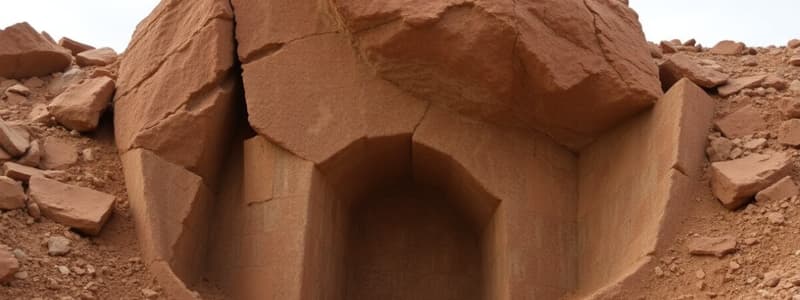Podcast
Questions and Answers
What is the main purpose of a seismograph?
What is the main purpose of a seismograph?
- To measure the temperature of the earth's core
- To detect and record ground motion (correct)
- To analyze soil composition
- To predict the weather
What term describes the series of tremors that often precede a main earthquake?
What term describes the series of tremors that often precede a main earthquake?
- Foreshocks (correct)
- Aftershocks
- Seismic waves
- Ground shaking
During an earthquake, what is the recommended action if you are inside a building?
During an earthquake, what is the recommended action if you are inside a building?
- Cover, Hold on, Drop (correct)
- Run outside immediately
- Stay standing to minimize panic
- Try to exit through windows
Which scale is typically used to measure the magnitude of an earthquake?
Which scale is typically used to measure the magnitude of an earthquake?
What should you do immediately after the shaking from an earthquake stops?
What should you do immediately after the shaking from an earthquake stops?
Study Notes
Seismology
- The study of earthquakes.
Seismologists
- Scientists who study earthquakes and their hazards.
Seismograph
- An instrument that detects and records ground motion during an earthquake.
Seismograms
- Graphical outputs from a seismograph.
Magnitude
- A measure of the energy released from the earthquake's source, also known as the hypocenter.
Richter Scale
- A scale used to measure the magnitude of an earthquake.
- Developed in 1935 by Charles Richter.
Foreshocks
- Tremors occurring before the main earthquake.
Aftershocks
- Weaker earthquakes that follow the main earthquake, potentially causing further damage.
Earthquake Hazards
- Ground shaking.
- Ground rupture.
Before Earthquakes
- Familiarize yourself with earthquake hazards in your area.
During Earthquakes
- Cover - Hold on - Drop:
- Cover your head and neck with your arms.
- Hold onto a sturdy piece of furniture.
- Drop to the ground.
After Earthquakes
- Evacuate as soon as the shaking stops, taking the fastest safe route.
- Expect aftershocks.
- Monitor the situation using electronic devices.
- Check yourself and others for injuries.
During Earthquakes (Specific Locations)
- If outside, move to an open area.
- If near a shore, move quickly to higher ground.
- Move away from steep slopes.
- Stop if inside a moving vehicle.
After Earthquakes (Specific Locations)
- Do not cross bridges or overpasses.
Studying That Suits You
Use AI to generate personalized quizzes and flashcards to suit your learning preferences.
Related Documents
Description
This quiz covers essential concepts in seismology, including the study of earthquakes, instruments used for measurement, and safety measures during such natural disasters. Test your knowledge on earthquake magnitude, Richter scale, foreshocks, and aftershocks.




